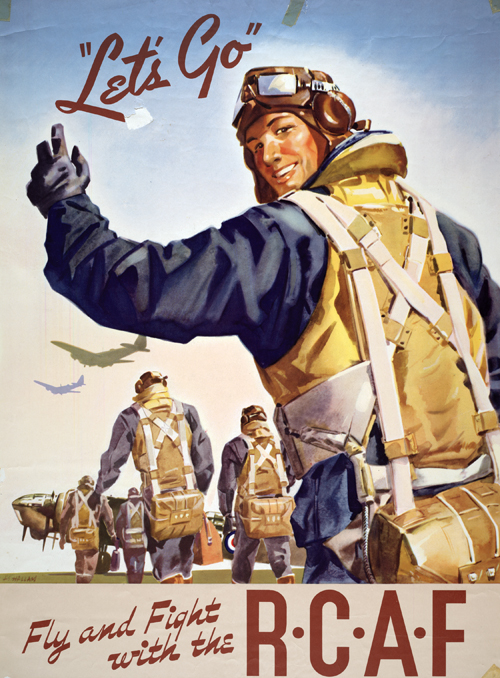Canada Remembers Times - 2006 Edition - Page 2
The Merchant Navy Saves the Day

Convoy in Bedford Basin. Photo Credit: LAC PA-112993
Canadians would make many great efforts and sacrifices to help the Allies triumph in the Second World War. One important job was carried out by the sailors of the Merchant Navy. They kept the flow of supplies moving from North America to England and the Allied forces fighting in continental Europe. Without this vital lifeline, the war could not have been won.
These brave sailors criss-crossed the dangerous waters of the North Atlantic for almost six years in the face of the deadly threat of German U-boats. The Battle of the Atlantic was the longest campaign of the war, lasting from the first day of the conflict to the last. Despite the best efforts of the enemy to break the supply lines, the Merchant Navy prevailed. This was not without a great cost however. More than 1,600 Canadian and Newfoundlander merchant sailors lost their lives in the effort.
Canada's own "Rosie the Riveter" with a Twist!

Elsie MacGill Photo Credit: LAC PA-148464
During the Second World War, hundreds of thousands of Canadian women answered the call to work in factories. They contributed greatly to the war effort by keeping our country's industrial production growing while freeing men to fight overseas. However, not many women pitched in quite the way Elsie MacGill did.
MacGill was the first woman to receive an Electrical Engineering degree in Canada and the first female aircraft designer in the world. In 1942, the aeronautical engineer took on the important job of supervising the Canadian production of Hawker Hurricane fighter planes at the Canadian Car and Foundry Company in Fort William, Ontario. In the process, she would win acclaim for her trail blazing contributions and earn the nickname "Queen of the Hurricanes."
Reduce, Reuse and Recycle on the Home Front

Photo Credit: WP2.R13.F3
Canadians on the home front contributed a lot to the war effort. It was a time of coming together as a country. We also reduced our consumption of goods that were in short supply, recycling and helping support the men and women serving overseas.
Goals were set to collect tons of used rubber products (which could be recycled into vitally-needed tires and other products important in the war effort). If these goals were not met, people were warned that the tires of non-essential vehicles could be seized! In this time of great need and sacrifice, everyone had to share the load and help Canada "roll on" to victory!
Gasoline was also rationed, with strict limits being set on how much could be used for different needs, such as personal use or agricultural requirements. Ration books were distributed to keep track of what people were allowed to have. This reduced waste so more gas could be sent overseas to help those fighting the enemy.
Women on the home front also contributed in other ways. Often they got together to make use of their domestic skills to support the war effort, doing things like knitting socks and gloves for the Canadians fighting overseas.
Youth Sharing the Story of Someone Who Cannot Share his Own

Kristy Bergman, Youth Ambassador 60th Anniversary of the Liberation of the Netherlands.
Photo Credit: VAC
There is a hero that I was never taught about in school ... a hero that gave all that it is possible to give. His name was Leonard Gordon Davies, and like myself, he called the vast plains of Saskatchewan his home.
Leonard joined his regiment overseas in Aldershot. They relocated to Northwest Europe. Leonard faithfully sent letters to his wife an ocean away twice a week for four years - letters which she has kept for all this time. I was able to read a letter that Leonard sent to his sister-in-law. He revealed his longing for his homeland, saying, "If I ever set foot on Canadian soil again, all the horses in Canada couldn't drag me off."
Leonard never did again see the shores of the country that he loved so much. Nor did he ever look into the eyes of his beloved wife. Just two months later, on April 9, 1945, Leonard was killed in action near the village of Haarle. He was 35 years old. He and the nine other soldiers that were killed that day were buried in Haarle, where the townspeople promised that they would lovingly care for their graves until their own deaths, and their children and grandchildren after them.
Asian-Canadians Behind Enemy Lines

Asian-Canadians contributed to our country's efforts during the Second World War in several ways. One role some of them played was unique and very perilous.
Britain had a special group called Force 136 that secretly operated behind enemy lines in the large areas of Southeast Asia which Japan had invaded and occupied. Since they often could blend in with local populations of occupied countries and speak the local language, hundreds of Asian-Canadians applied to join. While the war would end before many of them saw service, some did parachute into enemy territory and undertake dangerous tasks like recruiting and training native guerrillas, engaging in sabotage and ambush, and reporting on Japanese activities.
These brave men, like 19-year old Henry Fung of Vancouver who carried out strikes on Japanese communication lines and road convoys in Malaysia, were part of the great Allied effort that defeated Japan and finally brought the Second World War to an end.
- Date modified: